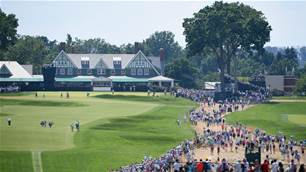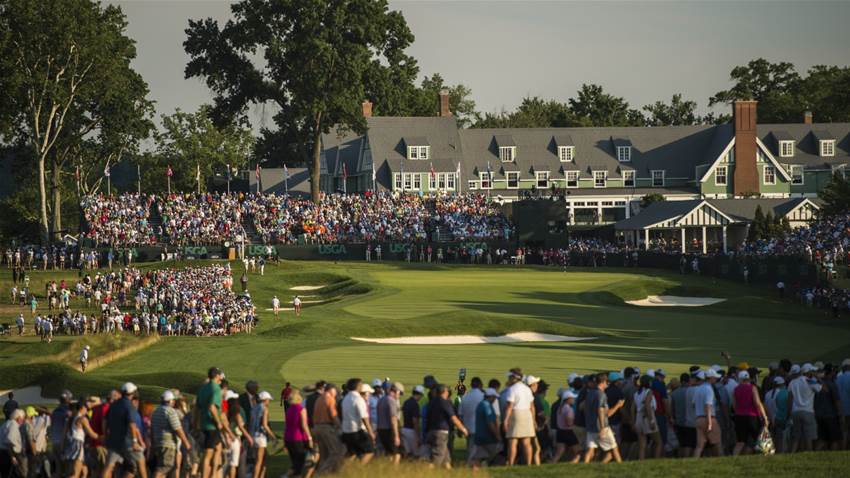The U.S Open returns to Oakmont Country Club for a record 10th time in the history of the championship, a venue the USGA clearly holds in high regard, with the belief it perfectly suits its premier event. Writer Garrett Johnston asked several players about the test Oakmont presents, how it is likely to play and what type of player will it favour.
A number of players immediately come to mind as strong contenders. For two-time U.S Open winner Andy North, there are three in particular which stand out.
“I think it’s the usual suspects who we often discuss in major championships: Scottie, Rory and Xander – the top guys,” North tells Golf Australia magazine. “Oakmont is a golf course that will always produce a deserving winner. Every time we’ve had an event there, it’s produced great champions, so I think the usual cast of characters will be up there.”

Among the top Aussies, Cam Smith finished 59th at Oakmont during the 2016 U.S Open, the last time the course hosted the event. He’s also notched two top-four finishes in nine attempts at the U.S Open, so it’ll be interesting to see how he performs this year. Jason Day tied for sixth at Oakmont in 2016 and in his 12 U.S Open appearances, boasts five top-10 finishes. Min Woo Lee has played in just three U.S Opens so far, but has had an impressive start with all of his finishes in the top 27, including a tie for fifth in 2023 at Los Angeles Country Club. The 26-year-old star comes into this year’s event with solid form, having secured his first PGA Tour win at the Houston Open in March.
Golf Australia magazine asked Schauffele in April, during a media call, what he thought of this year’s venue, with the American revealing he was yet to play Oakmont.
“Oakmont, I’ve heard, is the hardest course,” Schauffele said. “Pretty much every Tour pro I’ve talked to who has played there says that. I’m excited to see what everyone’s talking about. I’ve never played there. I may try to sneak out for a look soon, but we’ll see.”
Despite never playing a course before, Schauffele has still triumphed in major championships in similar circumstances. Last year he broke through for his first major title at the PGA Championship at Valhalla, despite it being his first time seeing the course during championship week. The same thing happened two months later at The Open Championship at Royal Troon, where Schauffele won in his debut at that venue. Perhaps Schauffele will continue this unlikely trend at Oakmont …

As for his U.S Open record, Schauffele has been exceptional. He’s played in eight versions of the tournament and has an eye-popping seven top-10 finishes, with his only other result being a modest tie for 14th. That’s a rare consistency at a major, one which even some of the game’s best struggle to maintain.
“I’m pretty happy with my record so far,” Schauffele said in a separate interview with this magazine. “It’s pretty clear that at the U.S Open, you need to play each hole smartly. On the Tour, it’s not always that obvious. At a U.S Open, it’s critical to hit the fairway off the tee. Your driving game needs to be dialled in. For some reason, I’ve driven it well on big courses in the past, which sets me up for success and avoids the big numbers.”
While weather conditions and course set-ups vary, Schauffele believes U.S Opens come down to what’s in front of you.
“To me, U.S Opens are an execution contest. If you’re in the rough, put it back in play and try to hit a solid wedge to save par,” Schauffele said.
 Scottie Scheffler, who’s played in seven U.S Opens, has posted three top-seven finishes, along with a couple of missed cuts – including one at Oakmont as an amateur in 2016. McIlroy, also at Oakmont that year, missed the cut by two shots and skipped media that Friday afternoon in frustration. Now that he’s donned the green jacket, he’s expected to be a factor this time around.
Scottie Scheffler, who’s played in seven U.S Opens, has posted three top-seven finishes, along with a couple of missed cuts – including one at Oakmont as an amateur in 2016. McIlroy, also at Oakmont that year, missed the cut by two shots and skipped media that Friday afternoon in frustration. Now that he’s donned the green jacket, he’s expected to be a factor this time around.
RIGHT: Dustin Johnson, the last player to win a U.S Open at Oakmont.
So, what’s the challenge like for those who have played Oakmont in past U.S Opens?
The champion from 2003, Jim Furyk, had plenty to share. “I think Oakmont is possibly the hardest layout I’ve ever competed on. Combined with U.S Open conditions – heavy rough, firm and fast greens – it’s an extremely difficult test,” Furyk told Golf Australia magazine. “Players rarely have many opportunities for birdies, so they need to limit mistakes.”
Furyk has a strong record at Oakmont. The former champion has tied for second in the last two U.S Opens held there. In 2007, he finished one shot shy of winner Ángel Cabrera, and in 2016, his Sunday round of 4-under 66 – almost unheard of at Oakmont – left him three shots behind winner Dustin Johnson.
“I’ll tell you, U.S Opens just beat you up. In a typical U.S Open setup, you’re tested physically and mentally. It’s gruelling,” Furyk said. “When conditions are right, the U.S Open becomes about who’s the last player standing. When I was playing well, that style suited my game. I enjoyed grinding out pars and often bogeys. It requires more patience than any other event in the world.”
Aussie Marc Leishman tied for 18th at Oakmont in 2016, his second-best finish in 11 U.S Open appearances.
“Oakmont is just so long and tough, but the greens are so diverse and undulating that they make it a great test,” Leishman said. “You really need to be solid in every aspect of your game to get into the right positions on the greens, especially if it plays firm.” As this magazine goes on sale, Leishman is attempting to qualify this year at the Final Qualifying in Maryland. “Hopefully my third time trying in Maryland will be the charm,” he said. He last played the U.S Open in 2022.

As the greens at Oakmont get lightning-fast, even some of the world’s best putters face the challenge of speed control. For Denny McCarthy, one of the game’s best putters, it’s all about knowing you won’t be able to leave putts cozy near the hole on Oakmont’s greens.
“Putting at Oakmont is a beast. The greens are so fast and undulating, and it’s tough to get lag putts dead near the hole,” McCarthy said. “You’ll often end up with four to eight-footers that are quick and still break. Many of those putts you’ve got to play outside the hole. Nothing comes easy on Oakmont’s greens.”
As tough as Oakmont Country Club is for the players, former pro Andy North will be excited to watch how the contenders handle the challenge.
“It will be awesome to watch. In my mind, Oakmont is one of the truly great U.S Open venues. It’ll be fantastic to return there. Overall, it’s going to be a hell of a test,” North said. “If you look at its history, it’s such a hard golf course. They had the U.S Amateur there a few years ago, and players were taking shortcuts, hitting it into other fairways or rough areas. But this year, I think the rough will be thick enough that they won’t be able to do that. I’m looking forward to watching a tough, challenging week for the players.”
What about caddying at Oakmont? How tough is that during a U.S Open? Paul Tesori caddied for Webb Simpson when he won the 2012 U.S. Open and now works with Tom Kim. He told Golf Australia magazine “it can be discouraging out there”.
“It’s just a brutal test and a tough course to caddie on,” Tesori said. “Usually, a caddie’s job is to manage targets based on where miss spots are, better or worse. At Oakmont, a missed fairway is bad no matter the side. The high rough and length make hitting greens from the rough very difficult. When you have enough missed fairways in a day – which you’ll certainly have at Oakmont – that just tires you out, mentally and physically.”
For competitors, it’s going to be a gruelling test and a long walk. In 2016, Kevin Streelman delivered his best finish in nine tries with a tie for 13th. Yet Streelman rates Oakmont “the fairest test of any U.S Open I played in”.
“Yes, it’s extremely challenging, but it felt like it was equally challenging from both sides of the rough lines,” Streelman said. “There’s no place to bail.”
There is no escaping it: Oakmont is a true U.S Open course and one of America’s toughest courses.
Related Articles

Ogilvy: U.S Open's toughness means testing limits

Cleary: Crime and punishment the USGA way, but it limits the U.S Open













